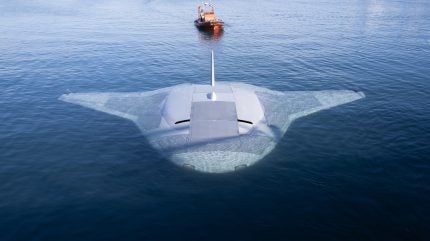
The increasing competition between the US and China in underwater drone technology is spurring investment and innovation, such as the Manta Ray underwater drone.
In an era where geopolitical tensions between the US and China often dominate headlines, a quieter but equally significant race is unfolding beneath the ocean’s surface. This competition drives investments in underwater drone technology, with implications for military sectors. GlobalData, a leading data and analytics company, reveals that these technological advancements reshape national security.

Discover B2B Marketing That Performs
Combine business intelligence and editorial excellence to reach engaged professionals across 36 leading media platforms.
Underwater drones are a niche segment primarily focused on military uses. According to GlobalData’s “Technology Foresights,” 157 patents related to underwater drones were filed between 2015 and 2023, indicating a burgeoning field of innovation.
” The underwater drone market is drawing new companies and substantial investments, signalling rapid growth potential,” says Rahul Kumar Singh, Senior Analyst of Disruptive Tech at GlobalData. These drones are becoming indispensable for applications such as environmental surveillance, facilitated by advancements in autonomous navigation and real-time data processing technologies.
Navies around the globe are increasingly investing in the development and integration of unmanned surface vehicles (USV) and unmanned underwater vehicles (UUV) to create ‘hybrid’ fleet structures in the interest of enhancing survivability, increasing efficiency, and reducing the long-term costs of naval operations, according to GlobalData’s “Thematic Intelligence: Unmanned Maritime Vehicles 2023” report.
Northrop Grumman’s Manta Ray prototype unmanned underwater vehicle (UUV) has completed in-water testing, demonstrating its modular design and readiness for real-world deployment.

US Tariffs are shifting - will you react or anticipate?
Don’t let policy changes catch you off guard. Stay proactive with real-time data and expert analysis.
By GlobalDataRecent funding highlights from GlobalData’s Deals Database illustrate a clear trend toward rapid innovation. For instance, US-based Terradepth has raised $28m to advance its Absolute Ocean platform, making ocean data accessible via the cloud. Similarly, Beijing Haizhou Unmanned Ship Technology’s Pre-Series A financing in March 2024 marks progress in autonomous maritime systems, reflecting China’s focus on this sector.
This trend is not confined to the US and China. South Korea’s Kalman, backed by a $370,000 investment from The Invention Lab, is enhancing its Lobster robot for nuclear plant inspections, emphasising the technology’s role in maintaining safety in high-risk environments. Meanwhile, Turkish startup AISField secured funding from Tupras Ventures to develop underwater drones for the energy sector, highlighting the global reliance on unmanned technologies.
However, the rapid advancement of underwater drone technology also presents challenges. Singh points out that issues such as cost-effectiveness and scalable production need to be addressed to fully realise the potential of these innovations. Despite these challenges, the continued investment and technological progress promise to improve how we interact with underwater environments, making them more resilient and adaptable to changing conditions.
While the US-China tech rivalry is a significant driver of innovation in underwater drone technology, the benefits of these advancements are poised to extend across multiple sectors, most obviously the military industry. As global powers invest heavily in enhancing their underwater capabilities, the resulting technological breakthroughs are set to transform military applications.





